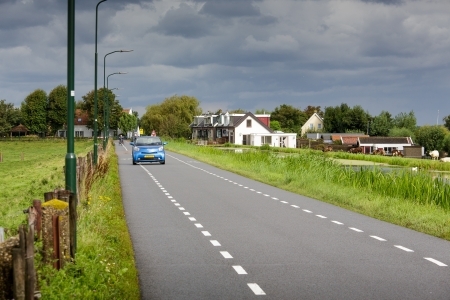Developments to consider in designing roads are developments in vehicle automation, the ageing population and increased use of (new forms of) active modes of transport.
More partially self-driving cars
More and more (new) vehicles are equipped with smart 'advanced driver assistance' systems (ADAS) such as lane keeping assistance, adaptive cruise control and blind spot detectors. In addition, there are now vehicles on the market in which part of the driving task is automated and which, for example, brake, accelerate and steer independently (see also SWOV fact sheet Self-driving vehicles). Since the lifespan of road infrastructure is about 30 years, these developments must be taken into account when building and redesigning roads. At the request of the Ministry of Infrastructure and Water Management, identification took place of the minimum facilities required to ensure road safety for all road users when automated vehicles are used in traffic [28]. Requirements for both the physical and the digital infrastructure were considered. With regard to the physical infrastructure, this involves requirements for road design, quality of the road surface, marking, signs and signage, and the subsequent compliance with these requirements. Some of these requirements can also be found in a more recent article in NM magazine, which discusses what measures road authorities can take to increase the effect of ADAS:
- Reduce the chances of lane boundaries not being detected by increasing the contrast value of markings until a highly accurate GPS system is available.
- Ensure the legibility of speed signs and regulations on (inadvertent) visibility of speed signs to road users for whom the sign is not intended.
- Develop an accurate and up-to-date digital map.
- Make traffic light control suitable for communication with vehicles.
Ageing
In recent decades, the proportion of the over-65s in the Dutch population has gradually increased. In 1980, 11% of the population was older than 65, in 2020 it was 20% [29]. According to a forecast by Statistics Netherlands, the share of the over-65s in the Dutch population will continue to rise to 26% around 2040 [30]. It will therefore become even more important to consider older road users when designing roads: see the question What is seniorproof road design?.
Increased use of (new forms of) active modes of transport
More and more people are cycling in the Netherlands. Mobility policy aims to promote cycling and walking because these modes of transport are healthy, environment-friendly and take up less space than motorised vehicles. This also affects the process of road design: CROW has published the STOMP[i] design principle [31], which prioritises sustainable forms of mobility in the design process.
Besides the use of active modes of transport, the variety of available (more or less) active modes of transport is also increasing. An increasing share of bicycle distance is travelled on pedelecs: KiM expects the share of pedelecs in total bicycle use to increase from 24% in 2019 to 46% in 2026 [32]. The popularity of speed pedelecs is also growing steadily (see SWOV fact sheet Pedelecs and speed pedelecs). In addition, a variety of new LEVs (Light Electric Vehicles) are under development (see SWOV fact sheet Light Electric Vehicles (LEVs)). These new modes of transport are not always easy to fit into the current traffic system. To ensure the safety of cyclists, only vehicles that are similar to regular bicycles in size, weight, speed and function can safely travel on bicycle tracks [33]. This means that vehicles that do not meet these requirements would have to be directed to the carriageway, which is used by vehicles faster and heavier than regular bicycles. There, however, other forms of incompatibility arise. For example, speed pedelecs are not easily compatible in terms of travel speed: they travel faster than cyclists on bicycle tracks, but slower than cars on the carriageway.
[i] In Dutch: Stappen, Trappen, OV, MaaS, Prive-auto. Best translated as: Walking, Pedalling, Public Transport, MaaS, Private Car
